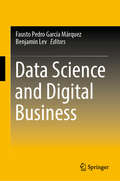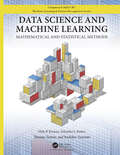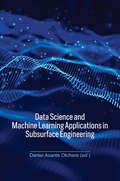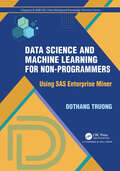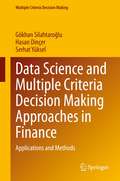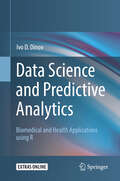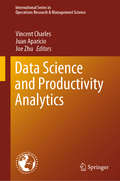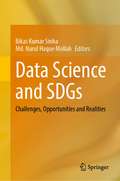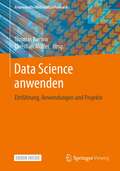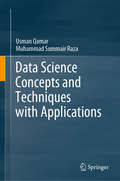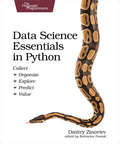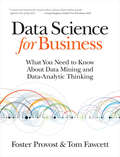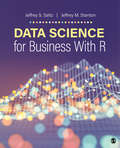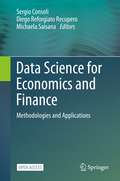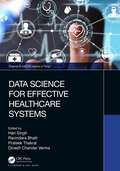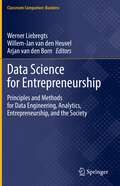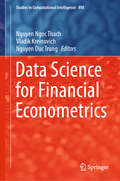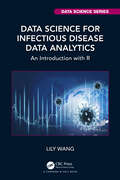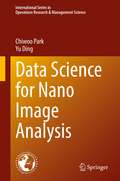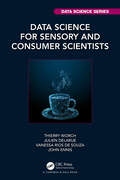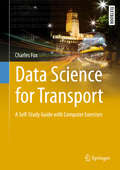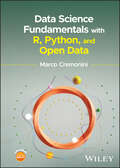- Table View
- List View
Data Science and Digital Business
by Fausto Pedro García Márquez Benjamin LevThis book combines the analytic principles of digital business and data science with business practice and big data. The interdisciplinary, contributed volume provides an interface between the main disciplines of engineering and technology and business administration. Written for managers, engineers and researchers who want to understand big data and develop new skills that are necessary in the digital business, it not only discusses the latest research, but also presents case studies demonstrating the successful application of data in the digital business.
Data Science and Machine Learning: Mathematical and Statistical Methods (Chapman And Hall/crc Machine Learning And Pattern Recognition Ser.)
by Dirk P. Kroese Zdravko Botev Thomas Taimre Radislav Vaisman"This textbook is a well-rounded, rigorous, and informative work presenting the mathematics behind modern machine learning techniques. It hits all the right notes: the choice of topics is up-to-date and perfect for a course on data science for mathematics students at the advanced undergraduate or early graduate level. This book fills a sorely-needed gap in the existing literature by not sacrificing depth for breadth, presenting proofs of major theorems and subsequent derivations, as well as providing a copious amount of Python code. I only wish a book like this had been around when I first began my journey!" -Nicholas Hoell, University of Toronto "This is a well-written book that provides a deeper dive into data-scientific methods than many introductory texts. The writing is clear, and the text logically builds up regularization, classification, and decision trees. Compared to its probable competitors, it carves out a unique niche. -Adam Loy, Carleton College The purpose of Data Science and Machine Learning: Mathematical and Statistical Methods is to provide an accessible, yet comprehensive textbook intended for students interested in gaining a better understanding of the mathematics and statistics that underpin the rich variety of ideas and machine learning algorithms in data science. Key Features: Focuses on mathematical understanding. Presentation is self-contained, accessible, and comprehensive. Extensive list of exercises and worked-out examples. Many concrete algorithms with Python code. Full color throughout. Further Resources can be found on the authors website: https://github.com/DSML-book/Lectures
Data Science and Machine Learning Applications in Subsurface Engineering
by Daniel Asante OtchereThis book covers unsupervised learning, supervised learning, clustering approaches, feature engineering, explainable AI and multioutput regression models for subsurface engineering problems. Processing voluminous and complex data sets are the primary focus of the field of machine learning (ML). ML aims to develop data-driven methods and computational algorithms that can learn to identify complex and non-linear patterns to understand and predict the relationships between variables by analysing extensive data. Although ML models provide the final output for predictions, several steps need to be performed to achieve accurate predictions. These steps, data pre-processing, feature selection, feature engineering and outlier removal, are all contained in this book. New models are also developed using existing ML architecture and learning theories to improve the performance of traditional ML models and handle small and big data without manual adjustments. This research-oriented book will help subsurface engineers, geophysicists, and geoscientists become familiar with data science and ML advances relevant to subsurface engineering. Additionally, it demonstrates the use of data-driven approaches for salt identification, seismic interpretation, estimating enhanced oil recovery factor, predicting pore fluid types, petrophysical property prediction, estimating pressure drop in pipelines, bubble point pressure prediction, enhancing drilling mud loss, smart well completion and synthetic well log predictions.
Data Science and Machine Learning for Non-Programmers: Using SAS Enterprise Miner (Chapman & Hall/CRC Data Mining and Knowledge Discovery Series)
by Dothang TruongAs data continues to grow exponentially, knowledge of data science and machine learning has become more crucial than ever. Machine learning has grown exponentially; however, the abundance of resources can be overwhelming, making it challenging for new learners. This book aims to address this disparity and cater to learners from various non-technical fields, enabling them to utilize machine learning effectively. Adopting a hands-on approach, readers are guided through practical implementations using real datasets and SAS Enterprise Miner, a user-friendly data mining software that requires no programming. Throughout the chapters, two large datasets are used consistently, allowing readers to practice all stages of the data mining process within a cohesive project framework. This book also provides specific guidelines and examples on presenting data mining results and reports, enhancing effective communication with stakeholders. Designed as a guiding companion for both beginners and experienced practitioners, this book targets a wide audience, including students, lecturers, researchers, and industry professionals from various backgrounds.
Data Science and Multiple Criteria Decision Making Approaches in Finance: Applications and Methods (Multiple Criteria Decision Making)
by Gökhan Silahtaroğlu Hasan Dinçer Serhat YükselThis book considers and assesses essential financial issues by utilizing data science and fuzzy multiple criteria decision making (MCDM) methods. It introduces readers to a range of data science methods, and demonstrates their application in the fields of business, health, economics, finance and engineering. In addition, it provides suggestions based on the assessment results on each topic, which can help to enhance the efficiency of the financial system and the sustainability of economic development. Given its scope, the book will help readers broaden their perspective on the assessment and evaluation of financial issues using data science and MCDM approaches.
Data Science and Predictive Analytics: Biomedical And Health Applications Using R
by Ivo D. DinovOver the past decade, Big Data have become ubiquitous in all economic sectors, scientific disciplines, and human activities. They have led to striking technological advances, affecting all human experiences. Our ability to manage, understand, interrogate, and interpret such extremely large, multisource, heterogeneous, incomplete, multiscale, and incongruent data has not kept pace with the rapid increase of the volume, complexity and proliferation of the deluge of digital information. There are three reasons for this shortfall. First, the volume of data is increasing much faster than the corresponding rise of our computational processing power (Kryder’s law > Moore’s law). Second, traditional discipline-bounds inhibit expeditious progress. Third, our education and training activities have fallen behind the accelerated trend of scientific, information, and communication advances. There are very few rigorous instructional resources, interactive learning materials, and dynamic training environments that support active data science learning. The textbook balances the mathematical foundations with dexterous demonstrations and examples of data, tools, modules and workflows that serve as pillars for the urgently needed bridge to close that supply and demand predictive analytic skills gap. Exposing the enormous opportunities presented by the tsunami of Big data, this textbook aims to identify specific knowledge gaps, educational barriers, and workforce readiness deficiencies. Specifically, it focuses on the development of a transdisciplinary curriculum integrating modern computational methods, advanced data science techniques, innovative biomedical applications, and impactful health analytics. The content of this graduate-level textbook fills a substantial gap in integrating modern engineering concepts, computational algorithms, mathematical optimization, statistical computing and biomedical inference. Big data analytic techniques and predictive scientific methods demand broad transdisciplinary knowledge, appeal to an extremely wide spectrum of readers/learners, and provide incredible opportunities for engagement throughout the academy, industry, regulatory and funding agencies. The two examples below demonstrate the powerful need for scientific knowledge, computational abilities, interdisciplinary expertise, and modern technologies necessary to achieve desired outcomes (improving human health and optimizing future return on investment). This can only be achieved by appropriately trained teams of researchers who can develop robust decision support systems using modern techniques and effective end-to-end protocols, like the ones described in this textbook. • A geriatric neurologist is examining a patient complaining of gait imbalance and posture instability. To determine if the patient may suffer from Parkinson’s disease, the physician acquires clinical, cognitive, phenotypic, imaging, and genetics data (Big Data). Most clinics and healthcare centers are not equipped with skilled data analytic teams that can wrangle, harmonize and interpret such complex datasets. A learner that completes a course of study using this textbook will have the competency and ability to manage the data, generate a protocol for deriving biomarkers, and provide an actionable decision support system. The results of this protocol will help the physician understand the entire patient dataset and assist in making a holistic evidence-based, data-driven, clinical diagnosis.• To improve the return on investment for their shareholders, a healthcare manufacturer needs to forecast the demand for their product subject to environmental, demographic, economic, and bio-social sentiment data (Big Data). The organization’s data-analytics team is tasked with developing a protocol that identifies, aggregates, harmonizes, models and analyzes these heterogeneous data elements to generate a trend forecast. This system needs to provide an automated, adaptive, scalable, and reliable prediction of the optimal investment, e.g., R&D allocation, that maximizes the company’s bot
Data Science and Productivity Analytics (International Series in Operations Research & Management Science #290)
by Vincent Charles Juan Aparicio Joe ZhuThis book includes a spectrum of concepts, such as performance, productivity, operations research, econometrics, and data science, for the practically and theoretically important areas of ‘productivity analysis/data envelopment analysis’ and ‘data science/big data’. Data science is defined as the collection of scientific methods, processes, and systems dedicated to extracting knowledge or insights from data and it develops on concepts from various domains, containing mathematics and statistical methods, operations research, machine learning, computer programming, pattern recognition, and data visualisation, among others. Examples of data science techniques include linear and logistic regressions, decision trees, Naïve Bayesian classifier, principal component analysis, neural networks, predictive modelling, deep learning, text analysis, survival analysis, and so on, all of which allow using the data to make more intelligent decisions. On the other hand, it is without a doubt that nowadays the amount of data is exponentially increasing, and analysing large data sets has become a key basis of competition and innovation, underpinning new waves of productivity growth. This book aims to bring a fresh look onto the various ways that data science techniques could unleash value and drive productivity from these mountains of data.Researchers working in productivity analysis/data envelopment analysis will benefit from learning about the tools available in data science/big data that can be used in their current research analyses and endeavours. The data scientists, on the other hand, will also get benefit from learning about the plethora of applications available in productivity analysis/data envelopment analysis.
Data Science and SDGs: Challenges, Opportunities and Realities
by Bikas Kumar Sinha Md. Nurul Haque MollahThe book presents contributions on statistical models and methods applied, for both data science and SDGs, in one place. Measuring and controlling data of SDGs, data driven measurement of progress needs to be distributed to stakeholders. In this situation, the techniques used in data science, specially, in the big data analytics, play an important role rather than the traditional data gathering and manipulation techniques. This book fills this space through its twenty contributions. The contributions have been selected from those presented during the 7th International Conference on Data Science and Sustainable Development Goals organized by the Department of Statistics, University of Rajshahi, Bangladesh; and cover topics mainly on SDGs, bioinformatics, public health, medical informatics, environmental statistics, data science and machine learning. The contents of the volume would be useful to policymakers, researchers, government entities, civil society, and nonprofit organizations for monitoring and accelerating the progress of SDGs.
Data Science anwenden: Einführung, Anwendungen und Projekte (Angewandte Wirtschaftsinformatik)
by Thomas Barton Christian MüllerDieses Buch bietet einen Einstieg in das Thema Data Science auf Basis der visuellen Aufbereitung von Daten. Es hat ethische Betrachtungen in der digitalen Transformation zum Gegenstand und stellt ein Prozessrahmenwerk für die Bewertung von Technologien vor. Außerdem erläutert es Besonderheiten und Erkenntnisse zum Scheitern von Data-Science-Projekten und stellt Empfehlungssysteme unter Berücksichtigung aktueller Entwicklungen vor. Funktionalität zu Machine Learning in Werkzeugen zu Business Analytics wird verglichen und der Einsatz eines Vorgehensmodells für Data Science aufgezeigt.Die Integration erneuerbarer Energien am Beispiel von Photovoltaikanlagen, ein effizienterer Umgang mit Wärmeenergie, wissenschaftliche Literaturauswertung, Kundenzufriedenheit in der Automobilindustrie und ein Framework für die Analyse von Fahrzeugdaten dienen als Anwendungsbeispiele für den konkreten Einsatz von Data Science. Das Buch bietet wichtige Informationen, die für Praktiker ebenso relevant sind wie für Studierende und Lehrende.
Data Science at Target
by Caitlin N. Bowler Srikant M. Datar<p>Paritosh Desai joined Target.com in 2013 as VP of Business Intelligence, Analytics & Testing to explore how the retailer could use its relatively small but thriving e-commerce arm to drive sales and win customers. The case explores the technological and organizational challenges Desai faced and the trade offs he considered in his four-year journey to develop the larger retail business into a data science organization. <p>Professor Srikant M. Datar and Research Associate Caitlin N. Bowler prepared this case. It was reviewed and approved before publication by a company designate. Funding for the development of this case was provided by Harvard Business School and not by the company. The citation review for this case has not yet been completed. HBS cases are developed solely as the basis for class discussion. Cases are not intended to serve as endorsements, sources of primary data, or illustrations of effective or ineffective management.</p>
Data Science at the Warriors
by Iavor Bojinov Michael ParzenAn introductory case for a data science course, which provides an overview of the data science pipeline.
Data Science Concepts and Techniques with Applications
by Usman Qamar Muhammad Summair RazaThis book comprehensively covers the topic of data science. Data science is an umbrella term that encompasses data analytics, data mining, machine learning, and several other related disciplines. This book synthesizes both fundamental and advanced topics of a research area that has now reached maturity. The chapters of this book are organized into three sections:The first section is an introduction to data science. Starting from the basic concepts, the book will highlight the types of data, its use, its importance and issues that are normally faced in data analytics. Followed by discussion on wide range of applications of data science and widely used techniques in data science.The second section is devoted to the tools and techniques of data science. It consists of data pre-processing, feature selection, classification and clustering concepts as well as an introduction to text mining and opining mining.And finally, the third section of the book focuses on two programming languages commonly used for data science projects i.e. Python and R programming language.Although this book primarily serves as a textbook, it will also appeal to industrial practitioners and researchers due to its focus on applications and references. The book is suitable for both undergraduate and postgraduate students as well as those carrying out research in data science. It can be used as a textbook for undergraduate students in computer science, engineering and mathematics. It can also be accessible to undergraduate students from other areas with the adequate background. The more advanced chapters can be used by postgraduate researchers intending to gather a deeper theoretical understanding.
Data Science Essentials in Python: Collect - Organize - Explore - Predict - Value
by Dmitry ZinovievGo from messy, unstructured artifacts stored in SQL and NoSQL databases to a neat, well-organized dataset with this quick reference for the busy data scientist. Understand text mining, machine learning, and network analysis; process numeric data with the NumPy and Pandas modules; describe and analyze data using statistical and network-theoretical methods; and see actual examples of data analysis at work. This one-stop solution covers the essential data science you need in Python.Data science is one of the fastest-growing disciplines in terms of academic research, student enrollment, and employment. Python, with its flexibility and scalability, is quickly overtaking the R language for data-scientific projects. Keep Python data-science concepts at your fingertips with this modular, quick reference to the tools used to acquire, clean, analyze, and store data.This one-stop solution covers essential Python, databases, network analysis, natural language processing, elements of machine learning, and visualization. Access structured and unstructured text and numeric data from local files, databases, and the Internet. Arrange, rearrange, and clean the data. Work with relational and non-relational databases, data visualization, and simple predictive analysis (regressions, clustering, and decision trees). See how typical data analysis problems are handled. And try your hand at your own solutions to a variety of medium-scale projects that are fun to work on and look good on your resume.Keep this handy quick guide at your side whether you're a student, an entry-level data science professional converting from R to Python, or a seasoned Python developer who doesn't want to memorize every function and option.What You Need:You need a decent distribution of Python 3.3 or above that includes at least NLTK, Pandas, NumPy, Matplotlib, Networkx, SciKit-Learn, and BeautifulSoup. A great distribution that meets the requirements is Anaconda, available for free from www.continuum.io. If you plan to set up your own database servers, you also need MySQL (www.mysql.com) and MongoDB (www.mongodb.com). Both packages are free and run on Windows, Linux, and Mac OS.
Data Science for Business: What You Need to Know about Data Mining and Data-Analytic Thinking
by Tom Fawcett Foster ProvostWritten by renowned data science experts Foster Provost and Tom Fawcett, Data Science for Business introduces the fundamental principles of data science, and walks you through the "data-analytic thinking" necessary for extracting useful knowledge and business value from the data you collect. This guide also helps you understand the many data-mining techniques in use today.Based on an MBA course Provost has taught at New York University over the past ten years, Data Science for Business provides examples of real-world business problems to illustrate these principles. You'll not only learn how to improve communication between business stakeholders and data scientists, but also how participate intelligently in your company's data science projects. You'll also discover how to think data-analytically, and fully appreciate how data science methods can support business decision-making.Understand how data science fits in your organization--and how you can use it for competitive advantageTreat data as a business asset that requires careful investment if you're to gain real valueApproach business problems data-analytically, using the data-mining process to gather good data in the most appropriate wayLearn general concepts for actually extracting knowledge from dataApply data science principles when interviewing data science job candidates
Data Science for Business With R
by Jeffrey S. Saltz Jeffrey Morgan StantonData Science for Business with R, written by Jeffrey S. Saltz and Jeffrey M. Stanton, focuses on the concepts foundational for students starting a business analytics or data science degree program. To keep the book practical and applied, the authors feature a running case using a global airline business’s customer survey dataset to illustrate how to turn data in business decisions, in addition to numerous examples throughout. To aid in usability beyond the classroom, the text features full integration of freely-available R and RStudio software, one of the most popular data science tools available. Designed for students with little to no experience in related areas like computer science, the book chapters follow a logical order from introduction and installation of R and RStudio, working with data architecture, undertaking data collection, performing data analysis, and transitioning to data archiving and presentation. Each chapter follows a familiar structure, starting with learning objectives and background, following the basic steps of functions alongside simple examples, applying these functions to the case study, and ending with chapter challenge questions, sources, and a list of R functions so students know what to expect in each step of their data science course. Data Science for Business with R provides readers with a straightforward and applied guide to this new and evolving field.
Data Science for Business With R
by Jeffrey S. Saltz Jeffrey Morgan StantonData Science for Business with R, written by Jeffrey S. Saltz and Jeffrey M. Stanton, focuses on the concepts foundational for students starting a business analytics or data science degree program. To keep the book practical and applied, the authors feature a running case using a global airline business’s customer survey dataset to illustrate how to turn data in business decisions, in addition to numerous examples throughout. To aid in usability beyond the classroom, the text features full integration of freely-available R and RStudio software, one of the most popular data science tools available. Designed for students with little to no experience in related areas like computer science, the book chapters follow a logical order from introduction and installation of R and RStudio, working with data architecture, undertaking data collection, performing data analysis, and transitioning to data archiving and presentation. Each chapter follows a familiar structure, starting with learning objectives and background, following the basic steps of functions alongside simple examples, applying these functions to the case study, and ending with chapter challenge questions, sources, and a list of R functions so students know what to expect in each step of their data science course. Data Science for Business with R provides readers with a straightforward and applied guide to this new and evolving field.
Data Science for Economics and Finance: Methodologies and Applications
by Sergio Consoli Diego Reforgiato Recupero Michaela SaisanaThis open access book covers the use of data science, including advanced machine learning, big data analytics, Semantic Web technologies, natural language processing, social media analysis, time series analysis, among others, for applications in economics and finance. In addition, it shows some successful applications of advanced data science solutions used to extract new knowledge from data in order to improve economic forecasting models. The book starts with an introduction on the use of data science technologies in economics and finance and is followed by thirteen chapters showing success stories of the application of specific data science methodologies, touching on particular topics related to novel big data sources and technologies for economic analysis (e.g. social media and news); big data models leveraging on supervised/unsupervised (deep) machine learning; natural language processing to build economic and financial indicators; and forecasting and nowcasting of economic variables through time series analysis. This book is relevant to all stakeholders involved in digital and data-intensive research in economics and finance, helping them to understand the main opportunities and challenges, become familiar with the latest methodological findings, and learn how to use and evaluate the performances of novel tools and frameworks. It primarily targets data scientists and business analysts exploiting data science technologies, and it will also be a useful resource to research students in disciplines and courses related to these topics. Overall, readers will learn modern and effective data science solutions to create tangible innovations for economic and financial applications.
Data Science for Effective Healthcare Systems (Chapman & Hall/CRC Internet of Things)
by Ravindara Bhatt Prateek Thakral Dinesh Chander Verma Hari SinghData Science for Effective Healthcare Systems has a prime focus on the importance of data science in the healthcare domain. Various applications of data science in the health care domain have been studied to find possible solutions. In this period of COVID-19 pandemic data science and allied areas plays a vital role to deal with various aspect of health care. Image processing, detection & prevention from COVID-19 virus, drug discovery, early prediction, and prevention of diseases are some thrust areas where data science has proven to be indispensable. Key Features: The book offers comprehensive coverage of the most essential topics, including: Big Data Analytics, Applications & Challenges in Healthcare Descriptive, Predictive and Prescriptive Analytics in Healthcare Artificial Intelligence, Machine Learning, Deep Learning and IoT in Healthcare Data Science in Covid-19, Diabetes, Coronary Heart Diseases, Breast Cancer, Brain Tumor The aim of this book is also to provide the future scope of these technologies in the health care domain. Last but not the least, this book will surely benefit research scholar, persons associated with healthcare, faculty, research organizations, and students to get insights into these emerging technologies in the healthcare domain.
Data Science for Entrepreneurship: Principles and Methods for Data Engineering, Analytics, Entrepreneurship, and the Society (Classroom Companion: Business)
by Willem-Jan Van den Heuvel Damian A. Tamburri Florian Böing-Messing Werner Liebregts Anne J. LafarreThe fast-paced technological development and the plethora of data create numerous opportunities waiting to be exploited by entrepreneurs. This book provides a detailed, yet practical, introduction to the fundamental principles of data science and how entrepreneurs and would-be entrepreneurs can take advantage of it. It walks the reader through sections on data engineering, and data analytics as well as sections on data entrepreneurship and data use in relation to society. The book also offers ways to close the research and practice gaps between data science and entrepreneurship. By having read this book, students of entrepreneurship courses will be better able to commercialize data-driven ideas that may be solutions to real-life problems. Chapters contain detailed examples and cases for a better understanding. Discussion points or questions at the end of each chapter help to deeply reflect on the learning material.
Data Science for Financial Econometrics (Studies in Computational Intelligence #898)
by Nguyen Ngoc Thach Vladik Kreinovich Nguyen Duc TrungThis book offers an overview of state-of-the-art econometric techniques, with a special emphasis on financial econometrics. There is a major need for such techniques, since the traditional way of designing mathematical models – based on researchers’ insights – can no longer keep pace with the ever-increasing data flow. To catch up, many application areas have begun relying on data science, i.e., on techniques for extracting models from data, such as data mining, machine learning, and innovative statistics. In terms of capitalizing on data science, many application areas are way ahead of economics. To close this gap, the book provides examples of how data science techniques can be used in economics. Corresponding techniques range from almost traditional statistics to promising novel ideas such as quantum econometrics. Given its scope, the book will appeal to students and researchers interested in state-of-the-art developments, and to practitioners interested in using data science techniques.
Data Science for Infectious Disease Data Analytics: An Introduction with R (Chapman & Hall/CRC Data Science Series)
by Lily WangData Science for Infectious Disease Data Analytics: An Introduction with R provides an overview of modern data science tools and methods that have been developed specifically to analyze infectious disease data. With a quick start guide to epidemiological data visualization and analysis in R, this book spans the gulf between academia and practices providing many lively, instructive data analysis examples using the most up-to-date data, such as the newly discovered coronavirus disease (COVID-19). The primary emphasis of this book is the data science procedures in epidemiological studies, including data wrangling, visualization, interpretation, predictive modeling, and inference, which is of immense importance due to increasingly diverse and nonexperimental data across a wide range of fields. The knowledge and skills readers gain from this book are also transferable to other areas, such as public health, business analytics, environmental studies, or spatio-temporal data visualization and analysis in general. Aimed at readers with an undergraduate knowledge of mathematics and statistics, this book is an ideal introduction to the development and implementation of data science in epidemiology. Features Describes the entire data science procedure of how the infectious disease data are collected, curated, visualized, and fed to predictive models, which facilitates effective communication between data sources, scientists, and decision-makers. Explains practical concepts of infectious disease data and provides particular data science perspectives. Overview of the unique features and issues of infectious disease data and how they impact epidemic modeling and projection. Introduces various classes of models and state-of-the-art learning methods to analyze infectious diseases data with valuable insights on how different models and methods could be connected.
Data Science for Nano Image Analysis (International Series in Operations Research & Management Science #308)
by Chiwoo Park Yu DingThis book combines two distinctive topics: data science/image analysis and materials science. The purpose of this book is to show what type of nano material problems can be better solved by which set of data science methods. The majority of material science research is thus far carried out by domain-specific experts in material engineering, chemistry/chemical engineering, and mechanical & aerospace engineering. The book could benefit materials scientists and manufacturing engineers who were not exposed to systematic data science training while in schools, or data scientists in computer science or statistics disciplines who want to work on material image problems or contribute to materials discovery and optimization.This book provides in-depth discussions of how data science and operations research methods can help and improve nano image analysis, automating the otherwise manual and time-consuming operations for material engineering and enhancing decision making for nano material exploration. A broad set of data science methods are covered, including the representations of images, shape analysis, image pattern analysis, and analysis of streaming images, change points detection, graphical methods, and real-time dynamic modeling and object tracking. The data science methods are described in the context of nano image applications, with specific material science case studies.
Data Science for Sensory and Consumer Scientists (Chapman & Hall/CRC Data Science Series)
by Thierry Worch Julien Delarue Vanessa Rios De Souza John EnnisData Science for Sensory and Consumer Scientists is a comprehensive textbook that provides a practical guide to using data science in the field of sensory and consumer science through real-world applications. It covers key topics including data manipulation, preparation, visualization, and analysis, as well as automated reporting, machine learning, text analysis, and dashboard creation. Written by leading experts in the field, this book is an essential resource for anyone looking to master the tools and techniques of data science and apply them to the study of consumer behavior and sensory-led product development. Whether you are a seasoned professional or a student just starting out, this book is the ideal guide to using data science to drive insights and inform decision-making in the sensory and consumer sciences. Key Features: • Elucidation of data scientific workflow. • Introduction to reproducible research. • In-depth coverage of data-scientific topics germane to sensory and consumer science. • Examples based in industrial practice used throughout the book
Data Science for Transport: A Self-study Guide With Computer Exercises (Springer Textbooks In Earth Sciences, Geography And Environment Ser.)
by Charles FoxThe quantity, diversity and availability of transport data is increasing rapidly, requiring new skills in the management and interrogation of data and databases. Recent years have seen a new wave of 'big data', 'Data Science', and 'smart cities' changing the world, with the Harvard Business Review describing Data Science as the "sexiest job of the 21st century". Transportation professionals and researchers need to be able to use data and databases in order to establish quantitative, empirical facts, and to validate and challenge their mathematical models, whose axioms have traditionally often been assumed rather than rigorously tested against data. This book takes a highly practical approach to learning about Data Science tools and their application to investigating transport issues. The focus is principally on practical, professional work with real data and tools, including business and ethical issues."Transport modeling practice was developed in a data poor world, and many of our current techniques and skills are building on that sparsity. In a new data rich world, the required tools are different and the ethical questions around data and privacy are definitely different. I am not sure whether current professionals have these skills; and I am certainly not convinced that our current transport modeling tools will survive in a data rich environment. This is an exciting time to be a data scientist in the transport field. We are trying to get to grips with the opportunities that big data sources offer; but at the same time such data skills need to be fused with an understanding of transport, and of transport modeling. Those with these combined skills can be instrumental at providing better, faster, cheaper data for transport decision- making; and ultimately contribute to innovative, efficient, data driven modeling techniques of the future. It is not surprising that this course, this book, has been authored by the Institute for Transport Studies. To do this well, you need a blend of academic rigor and practical pragmatism. There are few educational or research establishments better equipped to do that than ITS Leeds". - Tom van Vuren, Divisional Director, Mott MacDonald"WSP is proud to be a thought leader in the world of transport modelling, planning and economics, and has a wide range of opportunities for people with skills in these areas. The evidence base and forecasts we deliver to effectively implement strategies and schemes are ever more data and technology focused a trend we have helped shape since the 1970's, but with particular disruption and opportunity in recent years. As a result of these trends, and to suitably skill the next generation of transport modellers, we asked the world-leading Institute for Transport Studies, to boost skills in these areas, and they have responded with a new MSc programme which you too can now study via this book." - Leighton Cardwell, Technical Director, WSP."From processing and analysing large datasets, to automation of modelling tasks sometimes requiring different software packages to "talk" to each other, to data visualization, SYSTRA employs a range of techniques and tools to provide our clients with deeper insights and effective solutions. This book does an excellent job in giving you the skills to manage, interrogate and analyse databases, and develop powerful presentations. Another important publication from ITS Leeds." - Fitsum Teklu, Associate Director (Modelling & Appraisal) SYSTRA Ltd"Urban planning has relied for decades on statistical and computational practices that have little to do with mainstream data science. Information is still often used as evidence on the impact of new infrastructure even when it hardly contains any valid evidence. This book is an extremely welcome effort to provide young professionals with the skills needed to analyse how cities and transport networks actually work. The book is also highly relevant to anyone who will later want to build digital solutions to optimise urban travel based on emerging data sources". - Yaron Hollander, author of "T
Data Science Fundamentals with R, Python, and Open Data
by Marco CremoniniData Science Fundamentals with R, Python, and Open Data Introduction to essential concepts and techniques of the fundamentals of R and Python needed to start data science projects Organized with a strong focus on open data, Data Science Fundamentals with R, Python, and Open Data discusses concepts, techniques, tools, and first steps to carry out data science projects, with a focus on Python and RStudio, reflecting a clear industry trend emerging towards the integration of the two. The text examines intricacies and inconsistencies often found in real data, explaining how to recognize them and guiding readers through possible solutions, and enables readers to handle real data confidently and apply transformations to reorganize, indexing, aggregate, and elaborate. This book is full of reader interactivity, with a companion website hosting supplementary material including datasets used in the examples and complete running code (R scripts and Jupyter notebooks) of all examples. Exam-style questions are implemented and multiple choice questions to support the readers’ active learning. Each chapter presents one or more case studies. Written by a highly qualified academic, Data Science Fundamentals with R, Python, and Open Data discuss sample topics such as: Data organization and operations on data frames, covering reading CSV dataset and common errors, and slicing, creating, and deleting columns in R Logical conditions and row selection, covering selection of rows with logical condition and operations on dates, strings, and missing values Pivoting operations and wide form-long form transformations, indexing by groups with multiple variables, and indexing by group and aggregations Conditional statements and iterations, multicolumn functions and operations, data frame joins, and handling data in list/dictionary format Data Science Fundamentals with R, Python, and Open Data is a highly accessible learning resource for students from heterogeneous disciplines where Data Science and quantitative, computational methods are gaining popularity, along with hard sciences not closely related to computer science, and medical fields using stochastic and quantitative models.
